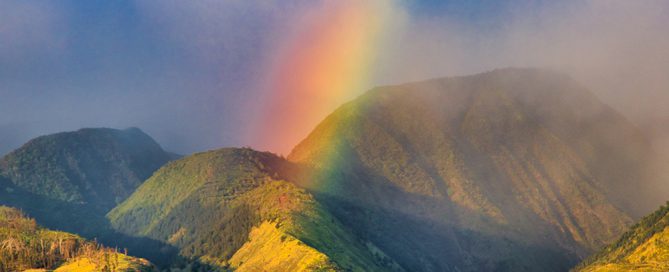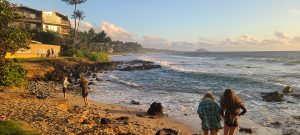A Guide to Understanding Maui's Diverse Weather

Discovering the weather nuances across Maui can be quite a journey, and it's important to understand the island's unique climate patterns while packing for your trip. Picture this: you might be experiencing snow at Haleakala's summit while folks on the beach are enjoying an 85-degree sunny day. That's just the tip of the iceberg! Even closer, it could be pouring rain near the airport, but just 15 miles away in Kihei, it's all blue skies and sunshine. Why? Let's dive into a simple guide to demystify Maui's quirky weather.
 Alright, let's start with the basics. Maui is roughly divided into four regions: central, leeward, windward, and upcountry. The weather rollercoaster is due to a couple of key players: The 10,000ft Haleakala volcano, and the West Maui Mountains. These mountains act like weather gatekeepers, directing rain to one side while keeping the other side dry. For instance, the east side of the West Maui Mountains might get a whopping 400 inches of rain annually, but head to the west side (Lahaina), and you're looking at a mere foot of rain per year.
Now, let's talk about the winds – the trade winds from the northeast dominate about 80% of the year, causing a jet stream-like effect around the mountains. On the flip side, the Kona Winds from the south bring a more unusual weather pattern, and occasionally some volcano ash fog (vog) from the Kona region on the Big Island of Hawaii. If you are staying on the sunny South or West side of Maui and experience unusual rain and wind, you may hear the phrase, "it's blowing Kona." These winds are generally less forceful than the trade winds, but still might send you searching for rainy day activities on Maui.
Here's the last piece of the puzzle: nearly half the island is within 5 miles of the ocean, creating a strong marine influence in some areas, while others remain untouched.
Maui weather by region:
Central Maui: When you land at the airport, you're in Central Maui, covering Kahului and Wailuku. Wailuku, nestled at the base of the West Maui Mountains, tends to be wetter than Kahului due to its proximity to the mountains. Both towns enjoy warm temperatures, less wind, and higher humidity compared to the leeward side.
Leeward side: The popular leeward side includes the south shore (Kihei/Wailea/Makena) and the west side (Lahaina, Kaanapali, and Kapalua). The West Maui Mountains play a crucial role in blocking rain and funneling winds, making it the sunniest, warmest, and driest part of the island. Just keep an eye on those afternoon winds that might stir up some sand on the beach.
Alright, let's start with the basics. Maui is roughly divided into four regions: central, leeward, windward, and upcountry. The weather rollercoaster is due to a couple of key players: The 10,000ft Haleakala volcano, and the West Maui Mountains. These mountains act like weather gatekeepers, directing rain to one side while keeping the other side dry. For instance, the east side of the West Maui Mountains might get a whopping 400 inches of rain annually, but head to the west side (Lahaina), and you're looking at a mere foot of rain per year.
Now, let's talk about the winds – the trade winds from the northeast dominate about 80% of the year, causing a jet stream-like effect around the mountains. On the flip side, the Kona Winds from the south bring a more unusual weather pattern, and occasionally some volcano ash fog (vog) from the Kona region on the Big Island of Hawaii. If you are staying on the sunny South or West side of Maui and experience unusual rain and wind, you may hear the phrase, "it's blowing Kona." These winds are generally less forceful than the trade winds, but still might send you searching for rainy day activities on Maui.
Here's the last piece of the puzzle: nearly half the island is within 5 miles of the ocean, creating a strong marine influence in some areas, while others remain untouched.
Maui weather by region:
Central Maui: When you land at the airport, you're in Central Maui, covering Kahului and Wailuku. Wailuku, nestled at the base of the West Maui Mountains, tends to be wetter than Kahului due to its proximity to the mountains. Both towns enjoy warm temperatures, less wind, and higher humidity compared to the leeward side.
Leeward side: The popular leeward side includes the south shore (Kihei/Wailea/Makena) and the west side (Lahaina, Kaanapali, and Kapalua). The West Maui Mountains play a crucial role in blocking rain and funneling winds, making it the sunniest, warmest, and driest part of the island. Just keep an eye on those afternoon winds that might stir up some sand on the beach.
 Upcountry: The coolest part of Maui, often reaching chilly temperatures in the 40s during winter, is what folks refer to as "upcountry" – think Makawao, Pukulani, Kula, and the highway to Haleakala. Upcountry residents enjoy cooler temperatures, ranging from the 70s to low 80s, and significantly less humidity compared to Central Maui.
Windward side: Made up of the north shore (Paia/Haiku) and the east side (Hana), the windward side boasts high winds in Paia and consistent rain around Hana. The northeast trade winds create excellent conditions for kiteboarding and windsurfing in Paia, making it a world-renowned spot for these activities. Venture along the Hana Highway, and as you climb Haleakala's side, you'll enter rainforests where it rains 365 days a year.
What happened to the beach?
Upcountry: The coolest part of Maui, often reaching chilly temperatures in the 40s during winter, is what folks refer to as "upcountry" – think Makawao, Pukulani, Kula, and the highway to Haleakala. Upcountry residents enjoy cooler temperatures, ranging from the 70s to low 80s, and significantly less humidity compared to Central Maui.
Windward side: Made up of the north shore (Paia/Haiku) and the east side (Hana), the windward side boasts high winds in Paia and consistent rain around Hana. The northeast trade winds create excellent conditions for kiteboarding and windsurfing in Paia, making it a world-renowned spot for these activities. Venture along the Hana Highway, and as you climb Haleakala's side, you'll enter rainforests where it rains 365 days a year.
What happened to the beach?
 Occasionally, a Kona Storm will be severe enough to temporarily take sand away from Leeward side beaches. While the sand eventually gets re-deposited courtesy of mother nature, the beach where you are staying could be transformed into a rocky coastline. No worries, there are plenty of other beaches to explore. If there is a grassy area above the washed out beach, it is a great spot to sit and watch big wave action- a treat normally reserved for people on the north shore.
Do I need to bring a coat to Maui?
Yup. You do need warm clothes if you plan to travel to the summit of Haleakala, or hiking in the rainforest. Even some of the towns Upcountry can be cool and breezy. Many spots on the windward side on the way to Hana can be misty or raining...it is what makes the rainforest a green jungle and feeds an amazing array of tropical plants and flowers. Layers are a great option, as you could travel through several microclimates in one day. If you start out with pants, light hiking shoes, and a t-shirt when headed to Hana or Upcountry, toss in a fleece, light raincoat outer shell with a hood and a pair of shorts and flip flops to give you plenty of options.
Understanding Maui's weather dance will help you navigate the island's diverse climates with ease.
Occasionally, a Kona Storm will be severe enough to temporarily take sand away from Leeward side beaches. While the sand eventually gets re-deposited courtesy of mother nature, the beach where you are staying could be transformed into a rocky coastline. No worries, there are plenty of other beaches to explore. If there is a grassy area above the washed out beach, it is a great spot to sit and watch big wave action- a treat normally reserved for people on the north shore.
Do I need to bring a coat to Maui?
Yup. You do need warm clothes if you plan to travel to the summit of Haleakala, or hiking in the rainforest. Even some of the towns Upcountry can be cool and breezy. Many spots on the windward side on the way to Hana can be misty or raining...it is what makes the rainforest a green jungle and feeds an amazing array of tropical plants and flowers. Layers are a great option, as you could travel through several microclimates in one day. If you start out with pants, light hiking shoes, and a t-shirt when headed to Hana or Upcountry, toss in a fleece, light raincoat outer shell with a hood and a pair of shorts and flip flops to give you plenty of options.
Understanding Maui's weather dance will help you navigate the island's diverse climates with ease.
February 6th, 2024 | Uncategorized




